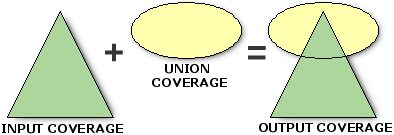Geoprocessing tool reference > Coverage toolbox > Analysis toolset > Overlay toolset > Tools
Union (Coverage) (ArcInfo only) |
|
|
Release 9.3
Last modified December 29, 2008 |



Print all topics in : "Tools" |
NOTE: This tool only works with an ArcInfo license and will only be available in ArcToolbox if you have installed ArcInfo Workstation.
Computes the geometric intersection of two polygon coverages. All polygons from both coverages will be split at their intersections and preserved in the output coverage.
Learn more about how Union works.
Illustration

Usage tips
-
The input coverage and the union coverage must have polygon topology.
-
Region subclasses in either the input or union coverage are maintained in the output coverage. Subclasses with identical names and attribute schemas are appended.
-
Label points are generated in each output coverage polygon. The new polygon User-IDs are set equal to the polygon internal number minus one.
-
The input coverage, union coverage, and output coverage must have different names, even when in different workspaces.
-
Existing input coverage annotation is copied to the output coverage by UNION.
-
Route systems in the input coverage will be maintained in the output coverage. However, UNION on routes and sections themselves is not permitted.
-
Region subclasses from both input coverage and union coverage are maintained. If the same subclass exists in both coverages, the subclass contents are appended. If the same subclass exists in both coverages but the item definitions are different, a message is given and the subclass is not propagated.
-
The coordinate precision of the output coverage is determined by the Precision for Derived Coverages environment.
-
Projection files will be compared for similarity using the level of comparison specified in the Compare Projections environment.
-
On single-precision coverages, UNION calculates a minimum tolerance based on the mathematical precision of the coverage (based on the width of the BND and the number of decimal places). If the calculated minimum tolerance is greater than the fuzzy tolerance entered, the calculated minimum tolerance is used.
-
Learn more about data model content inherited by the output.
-
Learn more about how the default fuzzy tolerance is calculated.
-
The following environments affect this tool: derivedPrecision, newPrecision, projectCompare, scratchWorkspace, and current workspace.
Command line syntax
An overview of the Command Line window
Union_arc <in_cover> <union_cover> <out_cover> {fuzzy_tolerance} {JOIN | NO_JOIN}
| Parameter | Explanation | Data Type |
| <in_cover> |
The coverage whose polygons will be combined with the union coverage. |
Coverage |
| <union_cover> |
The union coverage whose polygons will be combined with the input coverage. |
Coverage |
| <out_cover> |
The output coverage that will be created containing the results of the operation. |
Coverage |
| {fuzzy_tolerance} |
The minimum distance between coordinates in the output coverage. By default, the minimum fuzzy tolerance value from the input and erase coverages is used. Learn more about how the default fuzzy tolerance is calculated. |
Double |
| {JOIN | NO_JOIN} |
Specifies whether all items in both the input and the union coverages will be joined to the output coverage feature attribute table.
|
Boolean |
Command line example
union_arc h:\workspace\soil h:\workspace\timber h:\final\tiber_soil_un 0.0003 NO_JOIN
Scripting syntax
About getting started with writing geoprocessing scripts
Union_arc (in_cover, union_cover, out_cover, fuzzy_tolerance, join_attributes)
| Parameter | Explanation | Data Type |
| in_cover (Required) |
The coverage whose polygons will be combined with the union coverage. |
Coverage |
| union_cover (Required) |
The union coverage whose polygons will be combined with the input coverage. |
Coverage |
| out_cover (Required) |
The output coverage that will be created containing the results of the operation. |
Coverage |
| fuzzy_tolerance (Optional) |
The minimum distance between coordinates in the output coverage. By default, the minimum fuzzy tolerance value from the input and erase coverages is used. Learn more about how the default fuzzy tolerance is calculated. |
Double |
| join_attributes (Optional) |
Specifies whether all items in both the input and the union coverages will be joined to the output coverage feature attribute table.
|
Boolean |
Data types for geoprocessing tool parameters
Script example
# SimpleUnion.py
# Description: Simple example of using Union in a python script
# Requirements: Python and the Python win32all extension
# Author: ESRI
# Date 1/1/2004
# Create the Geoprocessor
import arcgisscripting
gp = arcgisscripting.create()
# Put in error trapping in case an error occurs when running tool
try:
# Union the parcels and counties to get the polys from both of these into one coverage
gp.workspace = "c:/work/gisdata"
gp.Union_arc("parcels", "counties","parcels2")
except:
# If an error occurred print the message to the screen
print gp.GetMessages()